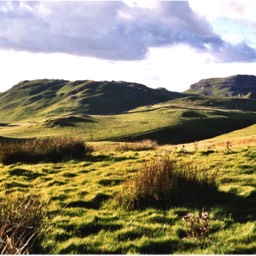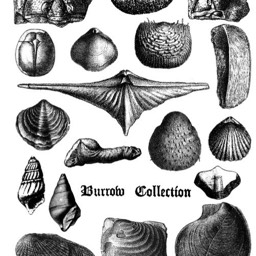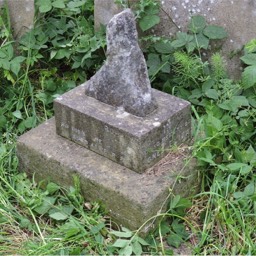
John Holme Burrow (1832 – 1876): Teacher, geologist and novelist - David J. C. Mundy
A modest headstone consisting of a double rectangular sandstone plinth, surmounted by a small, naturally weathered tusk of limestone, marks the grave of John Holme Burrow. Educated as a geologist, Burrow amassed an outstanding collection of Age fossils from his native North Yorkshire, the greater part of which now resides in the Sedgwick Museum, Cambridge. This collection furnished exceptionally well-preserved fossils which have been extensively used in palaeontological publications since 1862. In his later life, John Burrow received praise as a novelist, publishing three books.
J. H. Burrow was born in Settle, North Yorkshire, in 1832, the youngest son of Dr. Thomas Dixon Burrow, then surgeon in the town. He attended Giggleswick School until aged 18, then St Catharine’s College, Cambridge, graduating in 1855 with a B.A. (triple Honours in Mathematics, Classics and Natural Sciences, specialising in Geology).
After graduation, Burrow returned to the family home in Duke Street, Settle, where he occupied his time as teacher-cum-tutor, gentleman geologist and author. He was active in the Craven community and never shied away from giving his opinions on local issues, these typically voiced in the form of letters to regional newspapers (sometimes anonymously). His ardour for such communications was deemed by some as ‘irrepressible’, while others regarded his commentaries as sometimes ‘sarcastic’. John Burrow became interested in the local Craven geology and palaeontology whilst a schoolboy and started collecting fossils at that time. He continued these pursuits into his fourth decade and amassed an impressive collection of fossils, most of which were obtained from the Carboniferous (Mississippian) age limestones just east of Settle. Here, exposures on and around High Hill and Scaleber yielded very fossiliferous ‘reefal’ limestones which dated back some 335 million years. Burrow became very proficient with his field sampling techniques and was greatly respected for his ‘zealous’ labours and ‘patient energy’. The Burrow fossil collection (his ‘Cabinet’) was renowned for its size, diversity of taxa and the extremely good preservation of the specimens, many of which had been skillfully prepared. Geologists and palaeontologists visiting the Settle area routinely consulted with him on the local geology and would peruse the fossil collection. Burrow was acquainted with many of the specialist palaeontologists of the time and regularly reported on his finds and generously donated fossils to these workers. During his lifetime, he had many of his specimens figured in palaeontological papers and monographs. The collection provided numerous rarities, often the first documented occurrences of species in the UK, with several new to science.
The bulk of the Burrow collection (some 4000 specimens) was later acquired by the Woodwardian Museum, Cambridge (now the Sedgwick Museum) and continues to provide specimens for research and publication to this day. In fact, fossils from the collection have been used (described, figured or cited) in more than forty published works and now includes some 46 known type specimens. The palaeontological diversity of the collection is impressive, with representatives of corals, bryozoans, brachiopods, polyplacophorans, gastropods, rostroconchians, bivalves, nautiloids, goniatites, cycloids, phyllocarids, trilobites and ostracodes. Five of the new species from the collection are named in Burrow’s honour.
In his late twenties, John Burrow turned some of his attentions to writing and had modest success with adventure stories for the younger reader. His first work, ‘Stories for weekdays and Sunday’, was published in 1860 and was followed in 1863 by ‘The Adventures of Alfan, or the magic amulet’, reviewed as an ‘admirable story of a very old-fashioned and yet high-class kind in which a sound moral is taught’. His final novel, initially serialized, then published in three volumes in 1870, was ‘Jabez Oliphant, the modern prince’. This work, supposedly about fictional persons and communities in the Yorkshire Dales, is clearly based on the Settle district with some of the ‘fictional’ characters and locations not too subtly disguised. The work was generally well received for its clever and frequently amusing narrative but the response from the Settle community is not known.
At about the time ‘Jabez’ was serialised, John Burrow moved to London with his mother and older sister and occupied a house in Lansdowne Terrace, Kensington & Chelsea (now part of Ladbroke Grove, Notting Hill). The reason for the move from the Dales is unclear; it could be speculated that it was for medical reasons or possibly to be nearer his publishers. In April 1870, soon after the move, his mother died and the following year Burrow and his sister relocated to a house on Earl’s Court Road. Not much is known of Burrow in the last five years of his life; it appears he was suffering from a debilitating ‘wasting’ disease, most likely TB. He sold his prized fossil collection to the Woodwardian Museum in 1872, reportedly for a very modest price. John Holme Burrow died on 20 June, 1876 and was buried in Brompton Cemetery on 26 June. In February 1891 the body of his older sister Agnes Eliza Burrow (1825-1891), who had been a ‘landscape painter’, was interred in the same plot.
John Holme’s grave (No. 84899, Ref. E 73.6 + 39.3) is located on the eastern side of section E. The reference location from the origin in the N.E. corner of the section is 73 feet down the eastern side (following the path) and 39 feet in from the border of the section. This part of the cemetery is allowed to overgrow in the spring and summer and can sometimes be difficult to access.
Illustrations
Figure 1: Scaleber and High Hill (middle distance) just east of Settle, North Yorkshire where John Burrow collected most of his fossils.
Figure 2: A selection of figured fossils from the Burrow Collection; these examples appearing in publications between 1862 and 1933.
Figure 3: The headstone of John Holme Burrow’s grave in section E of the cemetery revealed from beneath Maytime overgrowth.
More posts
The Friends of Brompton Cemetery
North Lodge East Wing
Old Brompton Road
London SW5 9JE
Tel: +44 (0) 20 3876 4278


